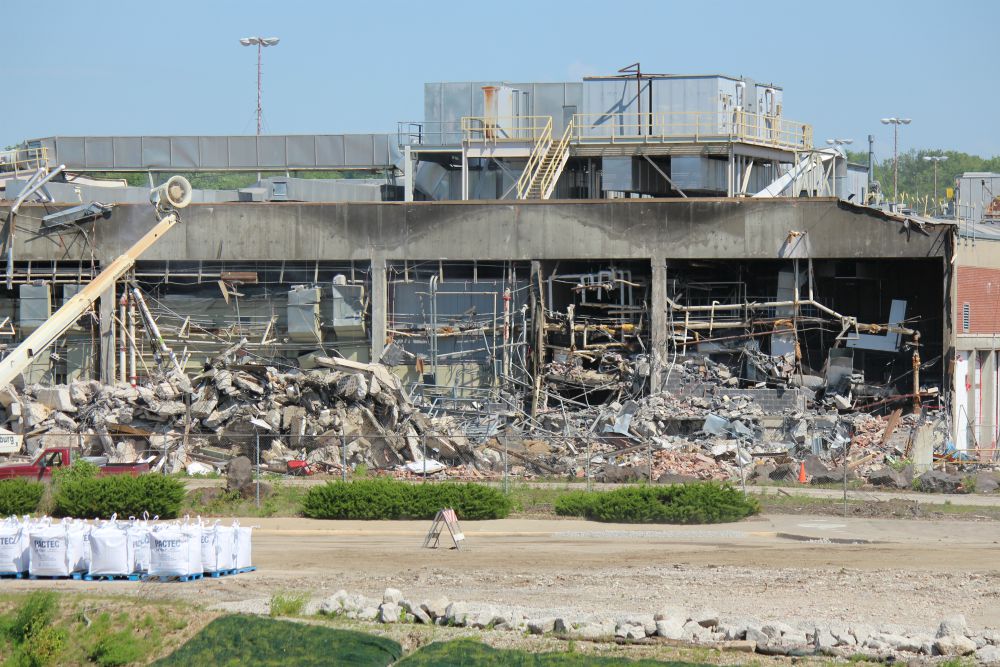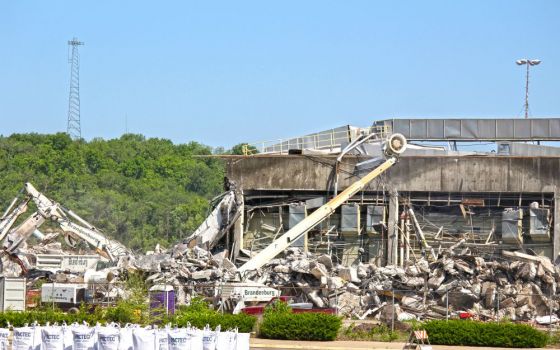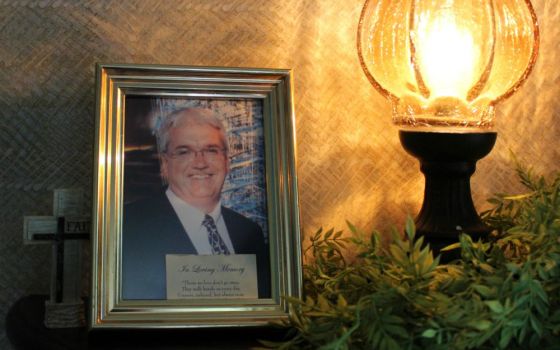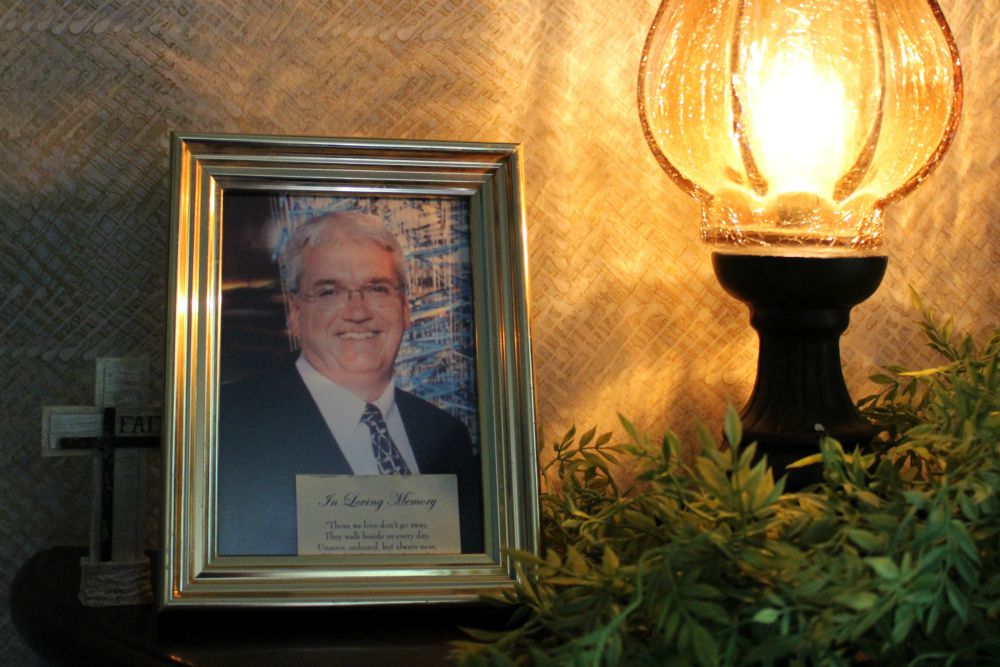
Bob Penniston died at age 50 in 2008 from complications of glioblastoma, a brain cancer. (NCR photo/Toni-Ann Ortiz)
Editor's note: As the government invests in the modernization of the U.S. nuclear arsenal, while weakening environmental regulations and federal laws protecting worker safety, National Catholic Reporter looks at the toxic legacy of one shuttered weapons plant in Kansas City, Missouri.
In a three-part series about the Kansas City Plant on Bannister Road and its successor 8 miles south, NCR reviews hundreds of pages of government reports and environmental summaries, and interviews more than two dozen sources, including five plant workers and their families, three former federal employees who worked nearby, nuclear industry and government officials, health experts, business sources, state environmental regulators and a former city councilman.
This is Part 1.

Debbie Penniston says her husband Bob loved a good practical joke. A naturally reserved man, he relished the laugh after the pranks they played on each other and their son. But on that family cruise in 2007, Debbie noticed Bob wasn't laughing. His affect was flat, "like a man without emotion," she said. His behavior was so atypical she wondered if their marriage was in trouble. "Do you want a divorce?" she asked him.
Bob's remoteness worsened the following year. Sometimes, he struggled to remember words. One Friday in April, he came home with a headache he couldn't describe. "He just wasn't making sense," Debbie said. At the hospital, doctors diagnosed glioblastoma, a fatal brain cancer. With that verdict, the Pennistons' future plans became suddenly irrelevant.

Deborah Penniston with the radiation treatment mask her late husband used (NCR photo/Toni-Ann Ortiz)
The couple chose an aggressive chemotherapy, which Debbie now regrets because it caused Bob's stomach to bleed horribly even as it shrunk the tumor in his brain. On the day after Thanksgiving 2008, 50-year-old Bob Penniston, committed husband, father and prankster, died. He basically bled to death, his wife said.
Debbie blames Bob's painful and untimely passing on his worksite. For 27 years, he worked as an engineer at the Kansas City nuclear bomb components plant, a proud and dedicated employee of what is now Honeywell Federal Manufacturing and Technologies LLC. Sworn to secrecy, Bob never discussed his work assignments with his wife. And she never asked. She is now convinced that whatever he did out there probably killed him.
During the decades of the Cold War, the Department of Energy (DOE) and its predecessor agencies employed hundreds of thousands of Americans in more than 350 secretive, hazardous worksites across the country, according to federal records. Scientists, engineers, machinists and laborers were hired to design, test and construct a stockpile of 70,000 nuclear warheads. Inadequately protected from carcinogens and toxins and often exposed without their knowledge, many nuclear workers became ill and died. They devolved into early dementia, endured high rates of miscarriages, suffered nerve disorders, and succumbed to a host of debilitating respiratory illnesses and cancers.
How many Americans died producing nuclear weapons is not a statistic the government tracks. "Irradiated," a 2015 investigative series by McClatchy DC, the Washington bureau of the media chain that owns The Kansas City Star, put the total at 33,480, four times the number of casualties in Iraq and Afghanistan. In its interpretation of the McClatchy DC data, the Columbia Journalism Review notes 33,480 is the number of American nuclear workers compensated by a government program who have died. "The government has acknowledged 15,000 of those deaths were due to work-related illnesses," the magazine writes. "The rest only had illnesses linked to their nuclear work and may have died of old age or unrelated causes."
Wayne Knox, a former industrial hygienist for DOE, thinks the death toll is "much, much higher" than 33,480.
The tally represents a price paid in American lives for the U.S. nuclear arsenal. Cities and communities that hosted weapons plants saw other costs: sick workers and their families who felt betrayed by the industry's indifference, and persistent environmental contamination.
As the government invests in the modernization of the U.S. nuclear arsenal, while weakening environmental regulations and federal laws protecting worker safety, National Catholic Reporter looks at the toxic legacy of one shuttered weapons plant in Kansas City, Missouri. In a three-part series about the Kansas City Plant on Bannister Road and its successor 8 miles south, NCR reviews hundreds of pages of government reports and environmental summaries, and interviews more than two dozen sources, including five plant workers and their families, three former federal employees who worked nearby, nuclear industry and government officials, health experts, business sources, state environmental regulators and a former city councilman.

Kansas City Plant power house, 2013 (Historic American Engineering Record, U.S. Department of the Interior/Richard Welnowski)
Located within a complex that housed other federal agencies, the Kansas City Plant manufactured electrical components for nuclear bombs, and for decades was publicly known as a non-nuclear worksite, a job-generator that offered a good salary.
An investigation by Kansas City television station KSHB 41, launched in 2009, revealed the plant used hundreds of toxins including uranium, depleted uranium, promethium and beryllium. (Watch videos from that investigative series here.) Over the course of the two-year probe, Channel 41 identified nearly 500 former employees or their family members who claimed chronic illnesses or premature deaths due to worksite exposure. Today, the abandoned plant is under demolition. The government relocated its weapons work farther south in Kansas City, leaving behind sick workers still seeking compensation and a contaminated complex that poses an environmental risk to surrounding neighborhoods.
Kansas City's story is not unique. It is being played out in varying detail in abandoned nuclear weapons facilities throughout the country, says Robert Alvarez, former senior policy advisor at the energy department.
"A very simple logic is at work here. In order to make the most dangerous weapons in the world, [workers] had to handle the most dangerous material in the world, and a lot of that dangerous material is still lying around posing risks to people," he said.
Map from the 2013 "Final Environmental Assessment for the Transfer of the Kansas City Plant, Kansas City, Missouri" showing the footprint of the Kansas City Plant, including the original Main Manufacturing Building used by Pratt and Whitney for airplane engine production during World War II. (U.S. Department of Energy, National Nuclear Security Administration)
'The building is sick'
The Kansas City Plant, where Bob Penniston worked, was part of the Bannister Federal Complex, a sprawling network of industrial and office buildings owned by the DOE and its subsidiary, the National Nuclear Security Administration, and the General Services Administration (GSA). The 300-acre property sits within a flood plain about 10 miles south of downtown Kansas City in a thickly settled residential area. The Blue River borders the site on the east. Along its southern boundary runs Indian Creek and Bannister Road.
In the 1920s, an auto racetrack and cornfields filled the boggy acreage between river and stream. During World War II, the suburban countryside, like so many rural locales in the U.S., rapidly became a site of military production. In seven short months in 1942 — "warspeed" one historian called it — federal contractors leveled the racetrack and fields to build a massive structure, known as the Main Manufacturing Building, where Pratt and Whitney, a Connecticut-based company, assembled engines for aircraft zooming over Europe and the Pacific.
Kansas City welcomed the new munitions factory with much aplomb. Three thousand people turned out for the groundbreaking of the plant, which at peak production employed 21,000 people.
Pratt and Whitney shuttered their operations at that site post war. Westinghouse Corporation had a stint at the federal complex, building jet engines for the U.S. Navy. In 1949, the Atomic Energy Commission, a DOE predecessor, contracted the Bendix Aviation Corporation to produce electrical and mechanical components for nuclear weapons, marking the beginning of the Kansas City Plant on Bannister Road. A succession of contractors followed — Bendix merged with Allied Corporation, which later merged with Signal Corporation that in 1999 combined with Honeywell.
Over the years, the plant's operations expanded into 38 buildings. The GSA occupied an additional 13. The new industry spurred local growth. Neighborhoods sprang up in the area, rapidly transforming south Kansas City into a go-to place for baby boom families.
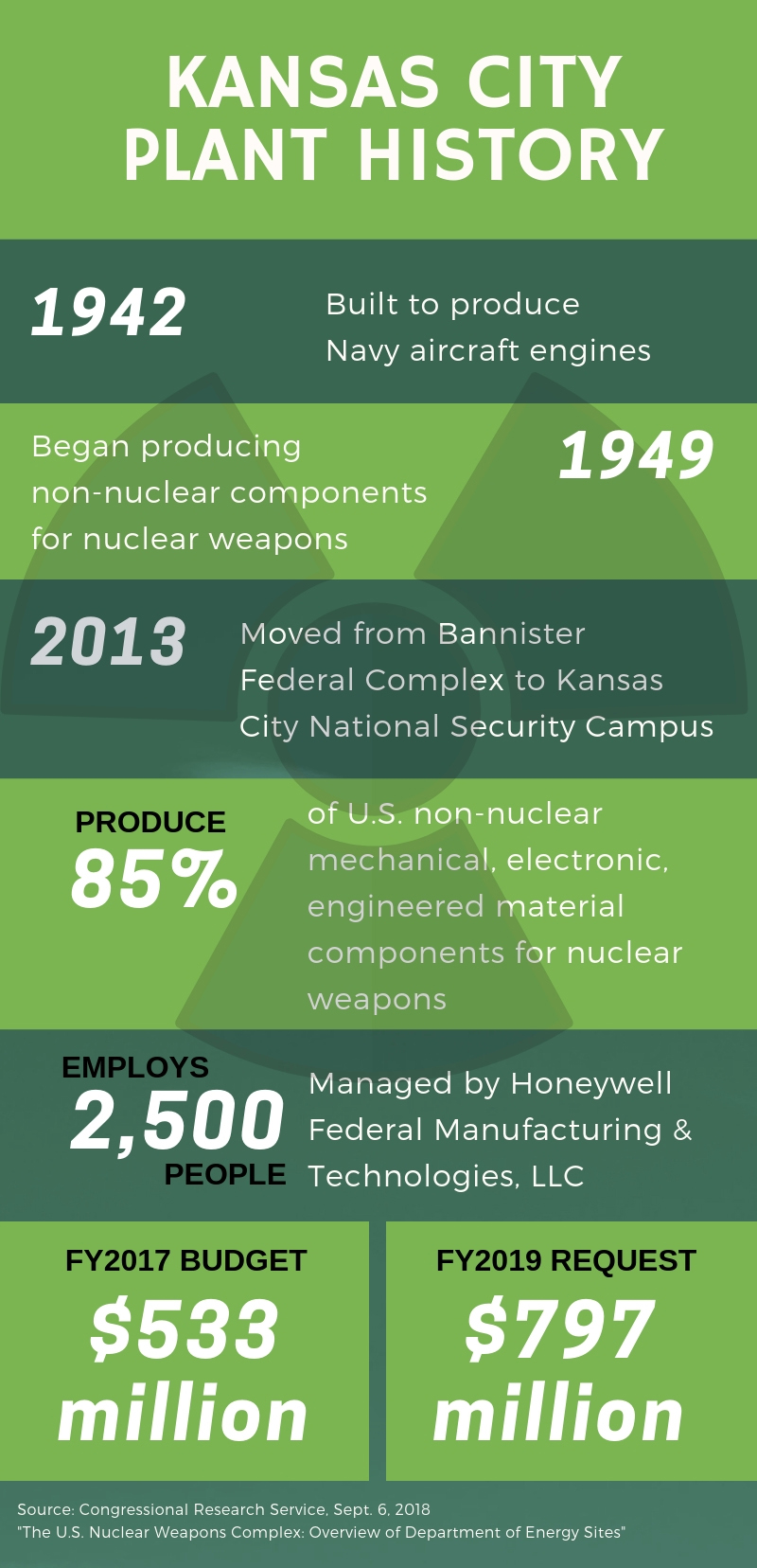
(NCR/Toni-Ann Ortiz)
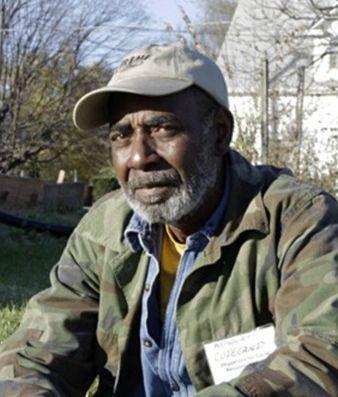
Maurice Copeland (Courtesy of The Pitch)
Amid the sprawl, the Main Manufacturing Building dominated the federal complex. At 2.7 million square feet, it matched the floor area of the Empire State Building.* The abundance in manufacturing space made the plant in Kansas City an important link in the chain of nuclear weapons production. For 60 years, it produced 85 percent of the non-nuclear components for the country's nuclear arsenal.
"The KCP was one of the best paying places in Kansas City," said Maurice Copeland, an African American who worked at the plant for nearly 30 years as a machinist and floor supervisor. Copeland was hired in 1968 at a time when the Bendix Corporation was recruiting Vietnam veterans, like himself, to meet the production demands of the Cold War. The workforce went from 3,000 to 9,000 "as fast as you can blink an eye," he said.
Working at the plant was a good option for a black man, Copeland said. The military contracts ensured job security. Because it was a federal facility, discrimination was less likely. Yet early on, he noticed workers, like a 27-year-old machinist, getting sick and dying young.
"We watched him die. We could see the man was sick," Copeland said. "Whenever anybody was quitting, or retiring, we used to look at them and make bets. 'That guy is not going to last three months out there.' We knew there were cancers. We didn't know why."
Other former employees gave similar summaries, describing the KCP as a place that paid well but exposed workers to hazards that later caused chronic illness or premature death.

Margaret Williams (Claire Schaeffer-Duffy)
"The building is sick," said Margaret Williams, 78, who worked maintenance from 1980 to 2003. Williams' job was to dump beryllium tailings into red hazmat containers that trash haulers loaded onto trucks for removal. The silver-grey metal, valued for its rigidity and used throughout nuclear weapons facilities to make bomb components, is an occupational hazard. Inhaling its dust or fumes can cause chronic or fatal lung disease including cancer, according to the Occupational Safety and Health Administration and the Centers for Disease Control and Prevention. Symptoms can take years to develop.
During Williams' early years at the plant, she worked with little protection, unaware she was handling hazardous material, she said. "We used nothing but cloth gloves and paper coats. Sometime around 1990-91, [internal] environmental health and safety came in, and thank God for that. They began giving us rubber gloves, masks."
Williams said the Kansas City Plant provided a physical every year or two, but these entailed a breathing test of blowing into a tube and were "not real physicals." Today, she suffers from shortness of breath and chronic fatigue. Doctors diagnosed her as beryllium sensitive and found a nodule in her lung, which they will re-examine in 2020, she said.
She described co-workers dying in their 50s, including some of the trash haulers who suffered "horrific" deaths from brain and lung cancers. "There have been so many, so many deaths. I won't go to the funerals anymore," Williams said. "They throw you into a depression."
"I felt like we were guinea pigs," said Tommy Lee Godard, 65, who worked as a machinist at the KCP from 1971 to 1974 and today suffers from chronic obstructive pulmonary disease, an ailment he says was common at the plant. Like Williams, he too can name co-workers who died in their 50s.
"They had one agenda out there, and that was to build those bombs. It was, 'Get things done, we don't care about the people building this thing.' They could have told us, so we could have said, 'I don't want to be exposed.' We should have been given an opportunity to make a choice. We didn't know, but they did."

Storage tanks at the Kansas City Plant, 2013 (Historic American Engineering Record, U.S. Department of the Interior/Richard Welnowski)
The long haul to compensation
From the outset, the hazards of nuclear weapons production were known. Yet for decades, the defense industry opposed compensating nuclear workers who claimed worksite-related illnesses, or even notifying them of exposure. To do so, they feared, would result in adverse publicity, a loss of worker morale, or union demands for hazardous duty pay.
"The government was more interested in production quotas and fending off liabilities. They looked at compensation as the dagger aimed at the heart of the national security program," said Alvarez, now a senior scholar at the Institute for Policy Studies, a progressive think tank in Washington, D.C.
From 1993 to 1999, Alvarez worked at the Department of Energy, serving as senior policy advisor to the secretary and deputy assistant secretary for National Security and the Environment. Troubled by DOE indifference to workers' health, he was instrumental in the creation of the Energy Employees Occupational Illness Compensation Program, which was established in 2001.
In "The Risks of Making Nuclear Weapons," a 2006 essay published by the Los Alamos Study Group, a research organization advocating nuclear disarmament, Alvarez documents a shocking history of the Atomic Energy Commission suppressing or ignoring studies that showed a strong correlation between cancer and workers' exposure to heavy metals and radioactive material used in nuclear production.
The compensation program was enacted to rectify past abuses. Part B of the program pays $150,000 for radiogenic cancers and lung diseases triggered by beryllium. Part E covers toxic exposure claims. Workers can receive up to $250,000 for wage loss and impairment. Survivor benefits are capped at $125,000. Both plans cover medical costs.
Advertisement
The Department of Labor oversees the compensation program with the National Institute for Occupational Safety and Health at the Centers for Disease Control and Prevention assisting in determining cancer claims.
According to its website, as of the week of May 12, the program has paid out almost $16.4 billion in medical bills and survivor benefits for 87,595 cases filed on behalf of nuclear employees or their families.
"On paper, [it] was a good law. We couldn't have asked for anything more," said Copeland.
Nonetheless, nuclear workers and their advocates have criticized the program's implementation, describing its excessive requirements and lengthy processes, as tactics used to "deny until you die." The program has been the subject of congressional inquiries and newspaper investigations. As recently as July 2017, a Labor Department whistleblower complained of "explicit hostility toward claimants" in an article posted on The Washington Free Beacon, a conservative news website. Attorney Stephen Silbiger accused government officials of manipulating the statute's regulations to deny claims.

The Kansas City Plant gates before 2017, top, and today, May 2019 (Google Maps, top, and NCR photo/Toni-Ann Ortiz)
Public and legislative scrutiny of the program over the years resulted in an increase in the number of workers compensated. In 2008, the successful claims return nationally was 25%. Today, it is 42%.
Not so at the Kansas City Plant where one in 6.3 cases (about 15%) filed have received compensation, according to Labor Department statistics. In the national constellation of nuclear weapons plants, the facility on Bannister Road was not considered a "dirty site," relatively speaking. It was not engaged in plutonium production like the plants in Savannah River, Georgia, or Hanford, Washington, which today are irreparably contaminated. In Kansas City, "they were mostly making the electronic packaging for the bomb," Alvarez said. The Kansas City Plant was considered non-nuclear.
But what did that really mean?
Details about the plant's manufacturing history were not publicly known and difficult to ascertain. Numerous contractors had managed the KCP over the years, and some records of work assignments had been lost or rendered illegible. As with all nuclear weapons facilities, some projects were classified. Moreover, employees signed non-disclosure agreements, obligating them to remain mute about their work.
To Kansas City residents, the federal complex on Bannister Road might have remained an innocuous, even beneficial, worksite had it not been for an unusual document that surfaced in late 2009 — a "death list" of nearly 200 former employees who claimed they became gravely ill after working there.
* This article has been updated to clarify a statistic.
[Claire Schaeffer-Duffy, a freelance writer, lives and works at the Sts. Francis and Therese Catholic Worker Community in Worcester, Massachusetts. She and her husband, Scott, co-founded the community in 1987. She has been contributing to National Catholic Reporter since 1999.]
Coming Wednesday, Part 2: 'What did they do on the other side of the wall?'

